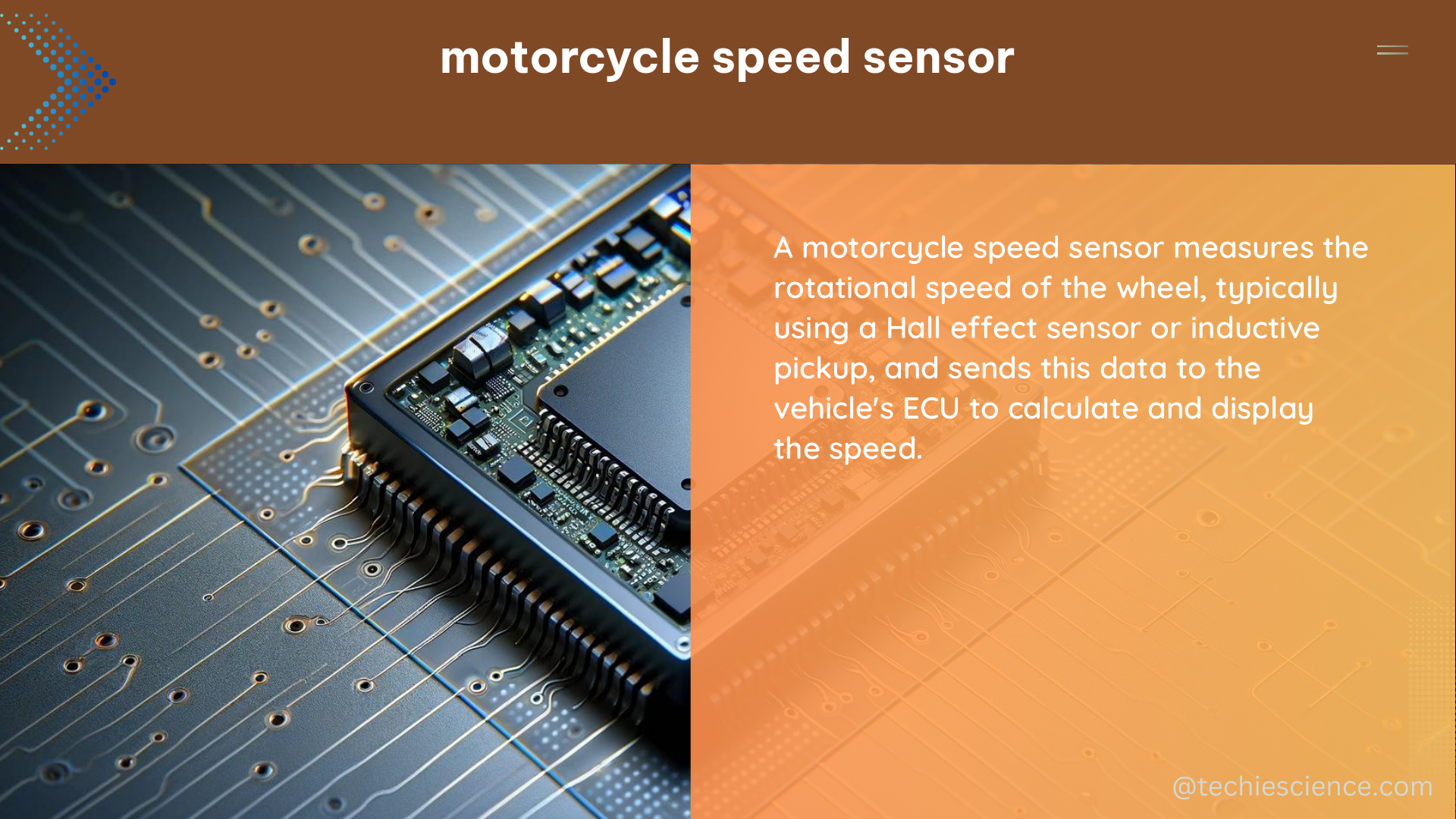The motorcycle speed sensor is a critical component that plays a vital role in accurately measuring the speed of a motorcycle. It works by detecting the rotation of a wheel or a toothed wheel (also known as a reluctor) attached to the wheel, and generating a signal that is proportional to the wheel’s rotation. This signal is then processed to calculate the vehicle’s speed, which is displayed on the motorcycle’s speedometer.
Types of Motorcycle Speed Sensors
There are two main types of speed sensors commonly used in motorcycles: Hall effect sensors and magnetic sensors.
Hall Effect Sensors
Hall effect sensors use a magnetic field to detect the rotation of a ferromagnetic object, such as a toothed wheel. When the toothed wheel rotates, the sensor detects the changes in the magnetic field, generating a signal that corresponds to the wheel’s rotation. Hall effect sensors are known for their reliability, durability, and ability to operate in harsh environments.
Magnetic Sensors
Magnetic sensors, on the other hand, use a magnet and a coil to generate a signal when the magnet moves relative to the coil. As the toothed wheel rotates, the magnet attached to the wheel moves in relation to the coil, inducing a voltage in the coil. This voltage signal is then used to calculate the wheel’s speed.
Factors Affecting Speed Sensor Accuracy

The accuracy of the speed sensor depends on several factors, including:
-
Number of Teeth on the Reluctor: The more teeth on the reluctor, the more accurate the speed measurements will be. A reluctor with a higher number of teeth can provide more data points for the sensor to detect, resulting in a more precise speed calculation.
-
Sensor Sensitivity: The sensitivity of the speed sensor plays a crucial role in its accuracy. Sensors with higher sensitivity can detect smaller changes in the magnetic field or the reluctor’s rotation, leading to more accurate speed measurements.
-
Processing Algorithm: The algorithm used to convert the sensor’s output signal into a speed value is also a significant factor. Advanced processing algorithms can better interpret the sensor’s data and provide more accurate speed calculations.
-
Sensor Placement: The location of the speed sensor on the motorcycle can also affect its accuracy. Typically, the sensor is placed near the front wheel, as it provides a more direct measurement of the vehicle’s speed.
Quantifiable Data
To understand the speed sensor’s performance, let’s look at some quantifiable data:
-
Hall Effect Sensor Output: A typical Hall effect sensor used in motorcycles can generate a signal with an amplitude of around 5 volts and a frequency proportional to the wheel’s rotation. For example, if the wheel rotates at a frequency of 1 Hz (one rotation per second), the sensor’s output frequency would be around 5 Hz.
-
Sensor Resolution: The resolution of the speed sensor is determined by the number of teeth on the reluctor. For instance, a reluctor with 60 teeth can provide a resolution of 6 pulses per wheel revolution (60 teeth / 10 revolutions per minute = 6 pulses/minute).
-
Speed Calculation: The processing algorithm can convert the sensor’s frequency output into a speed value, typically in miles per hour (mph) or kilometers per hour (km/h). For example, if the sensor’s output frequency is 50 Hz and the wheel circumference is 2 meters, the calculated speed would be approximately 50 km/h.
Sensor Calibration
To ensure accurate speed measurements, it is essential to calibrate the speed sensor properly. This process involves adjusting the sensor’s output signal to match the actual wheel rotation. Calibration can be done manually or using specialized tools and software.
During the calibration process, the sensor’s output is compared to a known reference, such as a GPS-based speed measurement or a calibrated speedometer. Any discrepancies between the sensor’s output and the reference are then used to adjust the sensor’s parameters, such as the number of teeth on the reluctor or the processing algorithm’s settings.
Proper calibration is crucial for maintaining the accuracy of the speed sensor over time, as factors such as tire wear, wheel size changes, and sensor drift can affect the sensor’s performance.
Conclusion
The motorcycle speed sensor is a critical component that enables accurate speed measurement, which is essential for various applications, such as speedometers, traction control systems, and engine management. By understanding the different types of speed sensors, the factors affecting their accuracy, and the importance of proper calibration, motorcycle enthusiasts and technicians can ensure their bikes are equipped with reliable and precise speed measurement systems.
Reference:
- DIY Digital Speedometer – Phase One – Bare Naked Embedded
- Measuring speed of a motorbike wheel – Sensors – Arduino Forum
- Vehicle Speed Sensor – Harley Davidson Forums
- Why is the speed of a motorcycle measured at the front wheel?
- speedometer – Honda Shadow Forums

The lambdageeks.com Core SME Team is a group of experienced subject matter experts from diverse scientific and technical fields including Physics, Chemistry, Technology,Electronics & Electrical Engineering, Automotive, Mechanical Engineering. Our team collaborates to create high-quality, well-researched articles on a wide range of science and technology topics for the lambdageeks.com website.
All Our Senior SME are having more than 7 Years of experience in the respective fields . They are either Working Industry Professionals or assocaited With different Universities. Refer Our Authors Page to get to know About our Core SMEs.